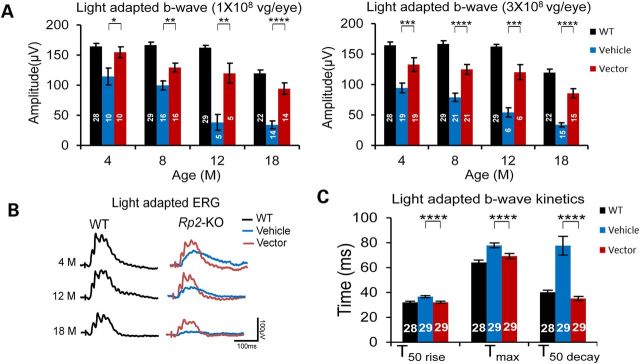Figure 4.

Preservation of ERG response in Rp2-KO mice that received vector treatment. Mice received unilateral injections of the AAV8-scRK-hRP2 vector and contralateral injections of vehicle at 4–6 weeks of age. (A) Light-adapted b-wave amplitude of Rp2-KO mice injected with 1 × 108 (left panel) or 3 × 108 vg/eye (right panel) of the vector. The stimulus intensities were from −1.0 to 2.0 log cd s/m2. Only the amplitude with the highest flash stimulus is shown. The ERG response with a full range of flash stimuli is shown in the Supplementary Material, Figure S4 and S5. Sustained higher amplitude was observed in vector-treated eyes than control eyes from 4 to 18 months of age. The number of mice tested in each group is indicated by white lettering inside each bar. The ages of the tested mice are indicated in the X-axis. ERG amplitudes from vector- and vehicle-injected eyes were compared by two-tailed paired t-test and represented as mean ± SEM. *P < 0.05, **P < 0.01, ***P < 0.001, ****P < 0.0001. ERG of age-matched WT mice shown in Figure 1 was used as reference. (B) Overlay of light-adapted ERG traces from vehicle- and 3 × 108 vg vector-injected eyes of an Rp2-KO mouse at different time points. ERG trace from an age-matched WT littermate is shown as control. While slower-b wave kinetics was observed in the vehicle-treated eye, the vector-treated eye displays a similar kinetics to that of WT. (C) Comparison between vehicle- and vector-treated eyes of Rp2-KO for their photopic b wave kinetics at 4 months. Age-matched WT littermates were used as references. While the vehicle-injected eyes exhibit a much slower kinetics of the b wave especially at the falling phase as indicated by the T50 decay, the vector-injected eyes display normal kinetics as the WT. Data from vector- and vehicle-injected eyes were compared by two-tailed paired t-test and represented as mean ± SEM. ***P < 0.001. In (A) and (C), the number of mice tested in each group is indicated by white lettering inside each bar.
